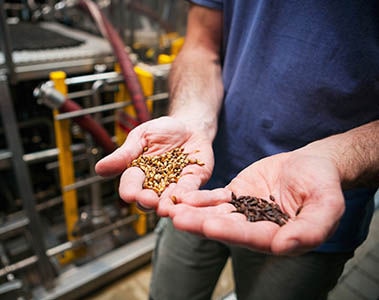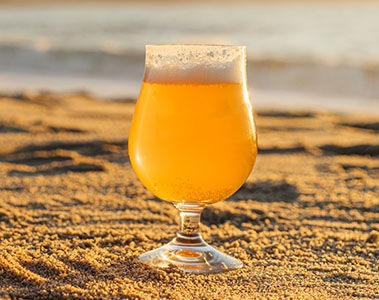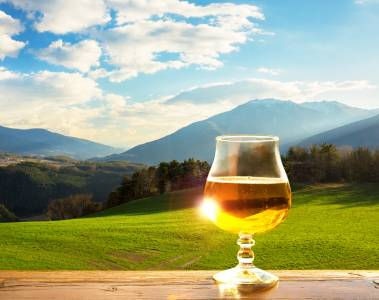
News
8月 13, 2022
ビール・プレミアムへの道
厳しい時代にチャンスと消費者の動向を探る
困難な時代にチャンスを求めて

困難な時代にチャンスを求めて
昔々、コーヒーバーに入って「スキニー・ラテ」を頼んだら、きょとんとした顔をされたものだ。 今ではもちろん、ビッグビジネスである。
では、醸造界に「痩せたビール」の時代が到来するのだろうか?
Slightly Mighty(アルコール度数4%、95カロリーの "Low-Cal IPA")から、Michelobやその95カロリーのUltraブランドのようなメジャーブランドまで、100カロリー以下のビールが徐々に台頭してきている。 近年のクラフト革命のように、このトレンドは、若くて目の肥えた消費者の新しい(そして増え続ける)波によって推進されている。
しかし、これまでとは違うビールの飲み方を求めるこの渇望は、単に低カロリーということだけではない。
私たちは皆、今日の目の肥えたビール愛飲者たちが、より多くの選択肢を求めていることを知っている。 重要な問題は、彼らがいったい何を選ぶのか、ということだ。 そして、私たち醸造業界は、非常に厳しい時代であることがわかっている中で、これにどのように対応すればいいのだろうか。

プレミアムへの道
我々の報告書によると、ビールは消費者からますますプレミアム商品として見られているようだ。 しかし、「プレミアム」はもはや味だけではない...。
特に、低カロリーのビールだけでなく、グルテンフリーのビールや「地ビール」(低アルコールでないビール)に対する強い需要があることが、私たちの調査で示された。
最も重要なことは、消費者がこうした魅力的な新しい機能性ビールのベネフィットにお金を払う用意があり、喜んで支払っているということだ。
サステイナビリティは引き続き重要な課題
気候変動が原材料の品質や入手可能性に影響を与え、生産者と消費者の双方に損害を与える可能性が高いことが明らかになりつつある。 さらに、持続可能な醸造はコスト削減を可能にし、業績向上につながる。 これを受けて、ビールメーカーはより持続可能な醸造方法に取り組んでいる。
例えば、ハイネケン( )は、二酸化炭素排出量削減への意欲を明確にするため、「Drop the C」プログラムを開始した。 カールスバーグ は、6パックの缶ビールをひとつにまとめるために(プラスチックの代わりに)接着剤を使用している(同社のサステナブルな取り組みについてはこちら )。 ABInbev は、醸造用の穀物を調達するアフリカの地元農家を支援するプログラムを実施している。ABInbevのサステナブルな野望については、こちら をご覧いただきたい。

小規模の醸造所も変化を望んでおり、クラフトビールの世界では、 、持続可能性の課題を受け入れ、推進する機会を巡る会話がますます増えている 。

保険料証明
私たちのレポートは、私自身の "個人的な "調査と一致していることを付け加えておきたい。
最近、兄に連れられて地元ポルトの新しいクラフトビール・パブに行った。 熱心なビール党の私は(ポルトガル北部の出身なので、いつもは スーパーボック )、膨大な種類のビールを見つけて驚いた。
それぞれのビールにストーリーがあり、産地、醸造方法、原料の調達先など、まるでビールの自伝を読んでいるようだった。 目玉は? 2つあった。
1つ目は、ポルトワインの樽で熟成させた超高級ビール! 2つ目は、太陽エネルギーで生産されたビール--私にとっては、二酸化炭素排出量の多いビールは飲みたくないので、これは大きな違いだ。
両者には共通する非常に重要な特徴があった:
彼らは 、プレミアムで高度に差別化された製品 、消費者(私のような)はプレミアム価格を支払うことに非常に満足していた。
オープンマインドな醸造家たちにとって、希望の光だ。
レポートダウンロード
DSMでは最近、最新の(独自に実施した)グローバル・インサイト・レポートの一環として、4大陸にまたがる1,000人のビール愛飲家に今後のトレンドについて尋ねた。
Looking for opportunity in challenging times
Once upon a time if you walked into a coffee bar and asked for a ‘skinny latte’ you would have been met with a puzzled expression. Today of course, it’s big business.
So, could we be about to see the ‘skinny beer’ come of age in the brewing world?
From the Slightly Mighty (a 4 percent ABV, 95-calorie “Low-Cal IPA) to major brands like Michelob and their 95-calorie Ultra brand we’re seeing the gradual emergence of the sub-100-calorie beer. Much like the Craft Revolution of recent years, this trend is being driven by a new (and ever-growing) wave of younger, discerning consumers.
But this thirst for a different beer drinking experience is not just about lower calories.
We all know that today’s discerning beer drinkers are looking for more choice. The key question is, what precisely will they be choosing? And how could we as a brewing industry react to this in what we all know are very challenging times?

The path to premium
Our report revealed that beer appears to be increasingly viewed by consumers as a Premium product. But ‘Premium’ isn’t just about taste anymore...
In particular, our research indicated a strong demand not just for low-calorie beer but also for gluten-free beers, ‘local’ beers (and no-low-alcohol beers).
Most importantly, we found that consumers are ready and willing to pay for these attractive new functional beer benefits.
Sustainability remains high on the agenda
It’s becoming clear that climate change will likely impact the quality and availability of raw materials, which will have damaging effects for both producers and consumers. In addition, sustainable brewing enables cost savings, which can drive improved performance. In response, brewers are making commitments to more sustainable brewing practices.
Heineken, for example, launched its ‘Drop the C’ program to articulate its ambitions for reduced carbon emissions. Carlsberg is using glue (instead of plastic) to keep six packs of beer cans together (read about their sustainable initiatives here), and ABInbev is running a program to support local farmers in Africa from which they source cereals for brewing. You can read more about ABInbev's sustainable ambitions here.

Smaller breweries want to make a difference too, and conversations in the world of craft brewing increasingly revolve around the opportunities to embrace and drive sustainability agendas.

Proof of premium
I’d like to add that our report tallies with my own ‘personal’ research.
My brother recently took me to one of the new craft beer pubs in my hometown of Porto. As an avid beer drinker (being from northern Portugal, it’s usually Super Bock all the way for me), I was astonished to find a vast array of beers.
Each had its own story: where it came from, how it was brewed, where the ingredients were sourced from... it was like reading a beer autobiography! The highlight? Well, there were two.
The first was a super high-end beer, aged in Porto wine barrels! The second, a beer produced using solar energy - which for me is a major point of difference because I don't want to drink beer with a huge carbon footprint.
Both had one very important characteristic in common:
They were premium and highly differentiated products that consumers (like myself) were very happy to pay a premium price for.
A ray of hope for open-minded brewers everywhere.
Download Report
Here at DSM we recently asked 1,000 beer drinkers spread across four continents about the upcoming trends as part of our latest (independently conducted) Global Insights Report.


